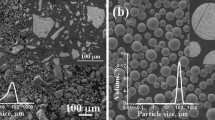Conclusions
Investigations have established that stable pores can exist in sintered WC-Ni hard metals. The equilibrium pore radius of a WC-Ni composite depends on the amount of the liquid phase and the size of the carbide particles.
Similar content being viewed by others
Literature cited
P. B. Anderson, Planseeber. Pulvermetall.,15, No. 3, 180–186 (1967).
A. F. Lisovskii, “Thermodynamics of the pore formation process in sintered composites,” Transactions of the Fifth International Conference on Powder Metallurgy in Czechoslovakia, Gotvaldov, Czechoslovakia, Oct., 1978, pp. 117–126.
S. A. Saltykov, Stereometric Metallography, Metallurgiya, Moscow (1976).
U. Suzuki, T. Tanase, and F. Nakayama, J. Jpn. Soc. Powder Powder Metall.,22, No. 6, 192–197 (1975).
Author information
Authors and Affiliations
Additional information
Translated from Poroshkovaya Metallurgiya, No. 5(197), pp. 44–47, May, 1979.
Rights and permissions
About this article
Cite this article
Lsovskii, A.F. Healing of a void in a sintered refractory-phase/liquid-metal composite. Powder Metall Met Ceram 18, 317–319 (1979). https://doi.org/10.1007/BF00791992
Received:
Issue Date:
DOI: https://doi.org/10.1007/BF00791992




